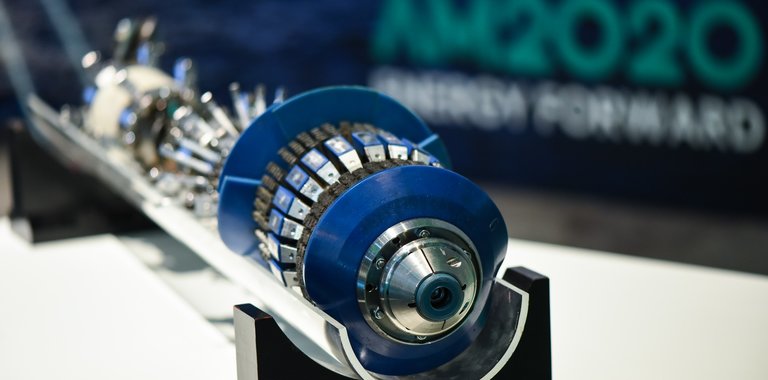Baker Hughes’s long heritage of providing accurate and reliable pipeline inspection data helps promote environmental and public safety along with asset integrity.
With almost 2 million kilometres of pipeline inspected worldwide during the last 45 years, our advanced assessment techniques deliver customer-focused pipeline integrity services. Our technological expertise, field experience, and advanced data management capabilities help our customers meet increasingly stringent regulatory requirements, and enhance the safety, productivity and life of their assets.
Managing corrosion and metal loss: industry leading inspection technology and expertise
Our solutions date back to the development of magnetic flux leakage tools in the 1960s, and we’ve continued to invest to evolve technological capabilities and help pipeline operators meet the highest levels of safety and performance that science can provide.
From the moment a pipeline is commissioned, it begins to deteriorate. No matter what cathodic protection system or coatings are used, or which product is in the pipeline, corrosion will eventually compromise pipe wall integrity. Operators require accurate defect detection, sizing and classification to determine actual growth rate and manage corrosion. We provide a range of magnetic and ultrasonic inspection technologies that each offer unique advantages. Your technology selection decision will be aligned with your objectives and underlying threats.
Crack management: reliable detection, location and sizing of crack-like features
Although a crack may be almost invisible to the eye, it can still weaken a pipeline enough to cause catastrophic failure. The types of cracks most likely to develop in operating pipelines are stress corrosion cracks (SCC), fatigue cracks, hydrogen-induced cracks and sulfide corrosion cracks. They can occur in the base material of the pipe, in welds and in the heat-affected zone adjacent to welds. Cracks can also appear in substandard axial and girth welds, and can occur in conjunction with other flaws such as dents, gouges and corrosion.
We’ve focused on finding solutions to your challenge to locate, identify, characterize and monitor the many types of cracks that may compromise pipeline integrity. Our technologies can inspect older pipelines, which have a propensity for weld-related cracks (seam, hooks). For accurate location and highlighting of cracks most likely to fail, our inspection capabilities can identify stress corrosion cracking (SCC) and cracks of unknown gestation. We also can employ recognized engineering techniques to predict rupture pressure when adjacent crack(s) interact, if extensive SCC crack fields are populated with both critical and subcritical cracks.
Pipeline geometry and mapping: pave the way for a successful ILI program and reliable feature location
Mapping and inspecting your pipeline at the same time helps and understand critical information on specific threats to pipeline integrity.
一个内部映射调查是一个具有成本效益的实现hod for determining locations of each pipe joint, making subsequent excavation of defects easier and cheaper. It can be a reliable means of producing pipeline drawings when none are available from earlier construction. Our mapping tools can run through remote, inaccessible areas where conventional above-ground mapping surveys are impractical. Mapping can also identify areas of pipeline movement from land slips in mountainous areas, ship anchors in offshore waters, fast water currents in flood zones and earthquakes and tremors in seismically active areas.
Integrity engineering: maximizing the efficiency of your ILI program
We offer proven, industry-accepted pipeline integrity engineering practices that support a pragmatic approach without jeopardizing pipeline safety. This comprehensive range of assessment techniques evaluates anomaly criticality and enables us to recommend control measures, repair processes or changes to the system process to promote long-term pipeline integrity.
Our range of services includeILI run comparison (RunCom) softwareto accurately align two ILI data sets and match corrosion sites to identify active corrosion growth sites,Integrity Assessmentsto determine and predict the immediate and future integrity of a pipeline andPipeline Curvature and Bending Strain Assessmentsto help operators identify locations where ground instability may pose a risk and affect pipeline integrity.Post Inspection Dent Assessment (PIDA) reportsuse local dent strain data to identify the need for and to prioritize repairs to pipeline dents whilePost Inspection Crack Assessment (PICA) reportsuse engineering criticality assessments to determine the acceptability and remaining life of crack indications found through ILI surveys.
These rigorous, regulatory compliant and quality assured assessment techniques and deliverables help pipeline operators use the value of ILI data to identify short and long-term integrity threats, avoid unnecessary and costly excavations and repairs while promoting safety and optimize long-term maintenance and repair schedules.
Line piggability: meeting the challenges of older pipelines and maximize asset condition
Many older pipelines around the world haven’t been inspected with inline tools because of various challenging features (eg: tight bends, multi-diameters, plug valves) and operating constraints such as low/no flow or inability to interrupt supply. Many of these pipelines are located in high-impact areas –and many operators now face a significant challenge: how to make their pipelines piggable.
To help address these unique challenges, we offer a diverse range of services to help minimize service disruptions and replacement costs while meeting local, national and international regulations. These include feasibility studies, in field support, repair solutions and customized cleaning.
Software solutions: intelligent data to drive safety and asset performance
Applying your organization’s data to assess and mitigate integrity risks may lead to a reduction in the likelihood and consequences of pipeline incidents. We offer intelligent data systems to support the Pipeline Integrity Management process:
- Complete and scalable solutions for pipeline data management, condition assessment, risk assessment and integrity management planning
- Comprehensive and system-wide pipeline risk assessment
- Effective management of large volumes of inspection and asset data
- 数据和结果来支持满足监管要求uirements, optimizing mitigation and maintenance costs and achieving longer asset life
Listening and locating outside force: real-time monitoring and detection
Damage due to outside force continues to be a leading cause of pipeline failure across the world. Accidental or intentional third-party damage is especially dangerous because it may go unreported at the time of occurrence, allowing defects to deteriorate for months or years. Another key damage source is ground movement, which can lead to fatigue cracking over time.
Baker Hughes’sThreatScan technologycan assess construction and third-party damage, or even suspected product theft. Any impact on a pipe wall will create acoustic waves and ThreatScan measures the timing and relative magnitude of these waves to determine the impact location and severity. Data is immediately transmitted via any type of communication network to a central system for detection analysis and alarm confirmation. You’re notified within a few minutes to enable effective decision-making. All sensor equipment attaches easily to above-ground pipeline features so no excavation is required. Unlike other monitoring methods, ThreatScan is not subject to weather conditions and provides continuous coverage.



